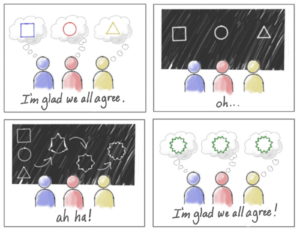What is a Team Working Agreement?
It’s helpful for team members to discuss, document, and occasionally revisit guidelines that inform their interactions with each other. Thus the purpose of a Team Working Agreement (TWA) is to capture team norms in an agreed-upon location.
What’s the Benefit?
Simply stated, the most significant benefit of creating/updating a TWA has to do with expectation-setting. What often happens in the absence of a TWA is the phenomenon that is visible in the “I’m Glad We All Agree” diagram by Jeff Patton, where people on the same team can have a very different understanding about important topics, such as what the team is trying to accomplish, what the most important thing is to work on, and so on. Having the type of conversation that leads to a TWA gets a team from the upper left quadrant of the diagram to the lower right – a much better place to be!

When?
A team that does not have a TWA can benefit from creating one at any time. The most common situations for teams to create or update a TWA:
- When the team is starting up
- When the team undergoes significant changes to its composition
Who Attends?
- A facilitator (often a Scrum Master or an Agile Coach)
- All of the team members
Inputs
- Arriving at the meeting with an open mind, in a spirit of continuous improvement
- Awareness of challenges the team is currently encountering
- Awareness of things that are going well which the team can build on
Outputs
- TWA (in a location that is known to everyone who needs to be aware of it)
Preparing for Success
The person who will be facilitating a meeting during which a TWA is to be created/updated is mostly likely to succeed when:
- One or more discussions with the team have occurred in advance
- All team members are on-board with notion of creating a TWA
- They have awareness of what is included in other TWAs, either for other teams in the same organization, or for teams external to the organization
Execution
Examples of topics that we commonly see in a TWA:
- How will we make decisions?
- How will we handle conflict?
- How will we run our meetings?
- How do we communicate?
- What are our values?
- How will we manage our work?
- How do we improve our processes?
- How do we have fun?
- How do we give each other feedback?
- How do we hold each other accountable?
- What is important information to us?
- What information do we need to radiate and how?
- What is our team’s definition of done? (see also Definition of Done )
- How do we interact with individuals and groups who are external to the team?
Examples of Team Working Agreements
A couple of noteworthy examples of Team Working Agreements are shown below.
- Ilio on Using Agile/Lean to Build Great Products: Example Working Agreement
- simpler.io Agile Working Agreement


